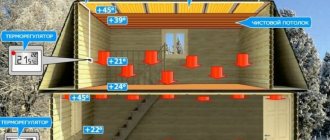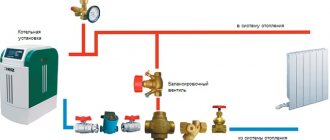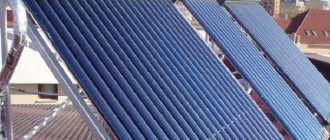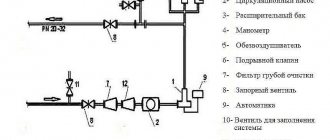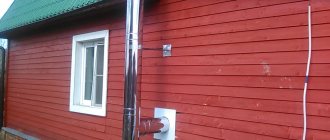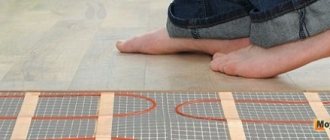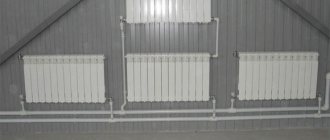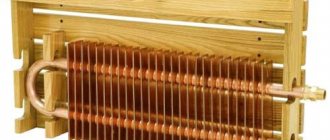Most owners of private houses are accustomed to gas heating from a boiler, which is considered the most economical and affordable. However, what about those where it is not possible to install such a heating system? An excellent alternative option is PLEN heating. Specifications, prices and reviews vary between models. We will analyze all the features and independent installation of such a “warm film”.
Installation option in a wooden house
What is PLEN heating
This technology is based on increasing the temperature of objects under the influence of radiation in the infrared range. The required result is achieved by passing electric current through a resistive element.
Design
Using this figure, you can study in detail a typical element of the PLEN heating system:
- To connect the power supply, special conductors (1) are installed, which are connected to special contact pads (3).
- The resistive strip (4) is laid in a “snake” pattern in strict accordance with engineering calculations. The uniformity of radiation is ensured and excessive heating is prevented.
- A thin aluminum layer (5) additionally smoothes the directional pattern of electromagnetic waves in the infrared range of the spectrum.
- The listed components are enclosed in a durable polymer shell (6). It does not prevent the spread of useful radiation, but reliably protects against the penetration of moisture and mechanical influences.
- The figure shows a holographic mark (2), which the manufacturer installs to identify potential buyers of quality products.
Installation diagram and principle of operation
Infrared heating PLEN (film emitter) is installed inside the ceiling structure. It is connected to the power supply via a thermostat. Radiation in this range passes through the decorative coating, heats the floor, furniture, and other objects in the corresponding impact zone. When the desired temperature level is reached, the system turns off to save energy. Further, the thermal mode set by the user is maintained automatically.
How it works
- You install the system and connect it to the power supply.
- Flowing through the resistive elements located between the PLEN films, electrical energy is converted into thermal energy. Due to direct contact with aluminum foil, which covers the entire plane of the film, heat exchange is ensured and then heat distribution throughout the entire substrate.
- Proper placement of resistive elements has a beneficial effect on creating a layer at different points of which almost the same temperature is maintained.
- A surface heated to a temperature of 40-45 °C becomes a source of infrared radiation in the mid-wave range.
- Reaching the opposite surface (in our case, the floor), the radiation is absorbed and releases heat.
- Thus, we get a heating surface with a relatively low temperature, uniformly heated and warming up the heavy lower layers of air and then throughout the entire room.
Advantages and disadvantages of the PLEN heating system
The following list shows the advantages, features and some important parameters of quality systems in this category:
- The conversion of electricity into heat is carried out efficiently, without unnecessary losses. Efficiency reaches 90-95%, which is 15-20% better than standard oil heaters.
- The temperature of the external surfaces of PLEN heating films does not exceed +50°C. This means that no additional measures are required to comply with the most stringent fire safety regulations.
- It is acceptable to place the PLEN film heater close to wooden and plastic parts. This simplifies installation and selection of suitable structural elements and finishing materials.
- At this temperature, mechanical particles contained in the room atmosphere do not burn.
- Convection flows are minimal for any placement of the PLEN heating system. This prevents the movement of dust, contamination of premises, and the occurrence of allergic reactions.
- The small thickness of the film means economical use of free space.
- IR emitters of this type are hidden behind decorative panels and functional coatings. They do not have any impact on the aesthetics of the interior.
- To connect such a heating system, you do not need proximity to a main gas pipeline.
- Laying cable routes is cheaper than installing pipes. Working operations are simplified by the low weight and high strength of film structures.
- Ceiling infrared heating performs its functions without chimneys, circulation pumps, boilers and boilers.
- Film emitters provide fast heating and operate completely silently.
- Their minimal inertia, together with the control principles, are well suited for inclusion in modern control complexes of the “smart home” category.
- With appropriate equipment, it is not difficult to maintain the temperature in individual rooms with high accuracy (±1-1.5°C).
- Good protection from external influences combined with gentle temperature conditions ensure a long service life. Modern models retain good consumer characteristics for 50 years or more.
“Pros” of PLEN: simple installation, inexpensive components, rational distribution of air temperature
As reviews indicate, a film heater really has many advantages. However, for an objective analysis it is necessary to consider the “cons” that are mentioned by the owners and some specialists in the field.
The heating area is limited by the direction of radiation. Outside the corresponding zones, the air temperature is noticeably lower. To maintain uniform temperature in the room, it is necessary to cover large areas with film emitters.
Despite the high efficiency and relatively low consumption per 1 sq. m. PLEN will have to take into account significant operating costs. The cost of heating using electricity is higher these days compared to gas. To connect, you will need a power source of appropriate power.
You can save additional money if you install a simple “potbelly stove” and engage in illegal logging
A serious analysis will help more accurately estimate the real costs when comparing PLEN with alternative heating systems. You can do it yourself, taking into account individual needs and operating conditions. Please pay attention to the following nuances:
- To use liquid heating systems, you need to purchase and install radiators, pipes, shut-off devices, a boiler, and other components.
- When using such equipment, it is necessary to provide reliable protection against freezing and prevent the formation of scale.
- To store relatively inexpensive solid fuel, you will need a warehouse. Handling it is accompanied by additional labor costs.
For your information! Some comments cite the following “disadvantage”: mandatory insulation of premises in accordance with the standards of current SNiP. But in fact, such measures are necessary when equipping any heating system. They increase the energy efficiency of the facility.
How to calculate heating power and calculate heat losses
If we assume that the initial temperature in the room is lower (for example, +16°C) than that set on the PLEN thermostat (+20°C), then the contacts of the thermostat will close, and power will be supplied to the PLEN, and the film will heat up.
By the way, according to the installation standards for PLEN, it is necessary to cover not 80% of the ceiling surface, but 65%-100%, depending on the climatic region. For the Urals, for example, this value is 60%-65%.
The power of 1 m² of PLEN is about 200 watts, which means that the specific power over the entire area will be:
200W x 65% = 130 watts.
That is, when the heating system is operating, every 1 m² of floor surface begins to be affected by a flow of thermal energy with a power of 130 watts.
When PLEN operates, air does not take part in heating the room, since heat is transferred directly, without intermediaries, from the film to the floor.
Wood has a very high emissivity coefficient (the ratio of the radiation energies of the “gray body” heat to the radiation of the “absolutely black body”) - 0.7-0.9, that is, almost all the heat energy will be absorbed by the floor surface, and the reflected part of it will be absorbed by others objects in the room.
As a result, the temperature of absolutely the entire floor surface will increase.
The air from contact with the floor will begin to heat up and rise upward, but it is under pressure from the colder and denser air in the upper layers. Diffusion of layers occurs, that is, their mixing.
Thus, the entire room will be filled with warm air. As soon as the air temperature at a height of 1.5 meters reaches +20°C according to the conditions of the task, the thermostat will operate and turn off the PLEN.
This process will take place cyclically, since the air takes heat from the floor surface quite slowly, and the floor, which has accumulated a sufficient amount of energy and has ceased to receive it, will begin to release the accumulated heat and cool down.
At some point, the air temperature at the thermostat will drop to +19°C, and it will turn on again. But the second heating cycle will proceed much faster, since the temperature difference is only 1°C.
All objects in the structure room are already heated, and their reheating will be faster.
Electricity consumption
Comprehensive tests of PLEN were carried out in 2008 at the Istanbul Technical University.
The experiment took place in a special chamber with a volume of 48 m³ (3x4x4 meters). All six planes of the cube had built-in metal tubes filled with water.
Five PLEN element heaters with a maximum power of 2650 watts were installed on the ceiling of the chamber.
The two walls of the chamber were equipped with water circulation using a chiller. Since the temperature of 2 of the six planes remained constant, during the research fixed heat losses were established, which can be calculated using the following formula:
Q=k x A x (T1-T2)
- K=5. This is the heat transfer coefficient of air.
- A – area of all planes (28 m²) with a constant temperature (+15°C, +12°C and +8°C) and 52 m² with variable temperature, which depended on the operation of the heating elements.
According to the conditions of the problem, the initial temperature of +20°C was set by a wall-mounted air thermostat. The temperature parameters in the chamber were memorized every half minute. In the same way, experiments were carried out with thermal losses of 3000 watts (+12°C) and 3400W (+8°C).
An interesting fact was noticed - when heating by convective method, when heat losses exceed the power of the heating system, the room should gradually cool down, but in the experiment, with a given system power of 750 watts (3400 W - 2650 W), the temperature in the room not only increased to the required +20°C, but Sometimes the thermostat would kick in, shutting down the system.
Below are the test results:
With a heat loss of 156 W/m²:
- The temperature on the cooling surfaces is +15°C.
- Heat loss in the room is 2500 watts.
- The operating time of the heating system is one and a half minutes.
- Shutdown time is 1 hour 27 minutes.
- Electricity consumption for 1 m² – 17 W/m².
- With a heat loss of 198 W/m²:
- The temperature on the cooling surfaces is +12°C.
- Heat loss of the room -3000 watts.
- System operating time is 16 minutes.
- Shutdown time – 38.5 minutes.
- Electricity consumption for 1 m² – 48.61 W/m².
An infrared heated floor under linoleum was built using the same principle. Very effective as additional heating.
The advantages and disadvantages of wall-mounted electric convectors can be found at:
Scope of application of the PLEN heating system
The use of high-quality infrared emitters is harmless to human health, pets, and plants. It does not damage decorative coatings and functional parts of building structures. The absence of significant restrictions predetermines a wide scope of application.
PLEN heating is used to equip apartments and cottages, offices and kindergartens, public and industrial facilities. When installed in warehouses and other large premises, the emitters can be mounted only above workstations, in aisles. Rational placement of equipment will help create comfortable conditions without unnecessary installation and operating costs.
Taking into account good protection from adverse external influences, it is permissible to use PLEN heating in a wide range of humidity and temperatures. The exact boundaries are set in the manufacturer's accompanying documentation.
Important! When developing a system, official recommendations on the operating parameters of thermostats and other components should be taken into account. The required degree of security is checked taking into account IP classification standards.
The specially designed switch performs its functions reliably even in open spaces
Scope of application
Despite the fact that some PLEN manufacturers position their products as an alternative to central heating, independent use of that system for heating a summer house, house, store, warehouse or other type of building in winter is not economically profitable. To do this, it is better to use a water boiler and a tubular floor heater, despite the fact that the installation of such equipment is much more complicated. As for industrial and production premises, gas emitters are more suitable for them.
Gas-radiant heating of the workshop is most efficient when installed on the ceiling
The ideal application area for IR films is an auxiliary heating system, which is used to heat a nursery, loggia, French balcony or floors of a private house.
This system can also be used to heat small auxiliary spaces, such as a garage, poultry or chicken coop, basement, etc. PLEN is often used as a soil heater in a polycarbonate greenhouse.
Taking into account the facts stated above, it can be stated that the efficiency of PLEN decreases with increasing heating area.
Main technical characteristics of PLEN heating
When choosing emissive films, pay attention to the following parameters:
- Power supply. As a rule, these products are designed for connection to a standard single-phase 220 V network. Some manufacturers indicate the permissible voltage deviation range (in %), which ensures that the nominal technical characteristics are maintained.
- The maximum current consumption will help you select the correct residual current devices for individual electrical circuits.
- Radiation flux density is indicated in W per 1 square meter. This value determines the efficiency of the device and allows you to correctly assess the capabilities of the heating system to heat a particular room.
- The power of one element is useful for calculating total consumption.
- The temperature on the surfaces of modern models does not exceed +45°C.
- Dimensions are needed to calculate the required number of PLEN heaters.
- The minimum thickness of a typical PLEN (approximately 0.3 mm) can be neglected when developing a project.
Some manufacturers offer thermostats and GSM units as a set or separately for creating a heating system. The parameters of these products are checked taking into account individual needs. If necessary, purchase analogues of other brands with better performance.
Operating principle and design of IR heating film
The main element in this design is a carbon coating; modern nanotechnology is used to apply it, allowing printing on a film base. The result is a unique atomic structure in the form of a hexagonal lattice, which is so small that to describe its dimensions it is necessary to use a nanometer scale (this order is expressed in 10-9 m). Thanks to this, the material acquires the ability to emit waves with a length of 5.0-20.0 microns, that is, those in the IR range (not to be confused with ultraviolet and infrared radiation).
Let us recall that the peculiarity of this radiation is that upon contact with matter, wave energy turns into heat. That is why such designs are also called PLEN heaters. This abbreviation stands for as follows:
- P – film.
- L – radial (radiant).
- E – electric.
- H – heating.
Film film can be produced in rolls or mats, their design is presented below.
Design of film electric heaters
Designations:
- A – Carbon (carbon) coating plays the role of the main heating element.
- B – Dense film base.
- C – Silver plating (used as an electrical conductor).
- D – Power bus, made of flexible copper tape.
- E – Film, used as a protective coating.
Options for production forms of PLEN heaters
Assortment of domestic manufacturer of film IR emitters
Standard products are produced with a width of approximately 0.5 m, a length from 1 to 5 m. It is not difficult to choose a set that exactly matches the size and configuration of a particular room. Please note the modification marked with an arrow. This is an autonomous film heater that can be mounted on the wall in any desired place.
In this design, PLEN becomes an element of interior decorative design
Structure and installation nuances
You can install this heating system yourself, but it is better to contact a specialist electrician. At a power of 5 kW, a single-phase input is recommended, and at higher powers, a three-phase input.
Under no circumstances should you mechanically or chemically influence the PLEN, change its dimensions or disassemble it!
Examples of sizes and characteristics of manufactured PLEN.
During installation, it is necessary to correctly direct the radiant energy. Plastic plugs will help secure each strip of heating film. These fastenings must be made carefully so as not to damage the film heater strips.
The influence of infrared radiation from PLEN heating on human health
High-quality devices of this type generate waves with a length of more than 9 microns. This radiation is completely safe for humans. It is not able to penetrate deep into the skin. It cannot be used for tanning. Relevant certifications confirm the possibility of using PLEN heating in medical institutions, schools, universities, kindergartens, and residential buildings.
For your information! With high-quality insulation of the room, the film emitter operates for 4-10 minutes per hour (after the air temperature rises to the operating value).
Calculation of PLEN energy consumption using the example of a house of 100 square meters. m
Our homes lose the most heat through windows, doors, floors and roofs. By choosing the best building and finishing materials, you can save a lot on heating costs.
We have already calculated how much film is needed. But will heating really “eat up” so much electricity? In fact, the costs will be small. Firstly, PLEN heating does not work around the clock - it turns on and off, obeying the thermostat. And secondly, infrared heating is economical. Therefore, the costs will not be very high.
If the house has good thermal insulation, then PLEN will work for about 10-15 minutes per hour . Based on the average cost of 1 kW of energy at 4 rubles, the cost of round-the-clock operation for a house of 100 sq. m would be 960 rubles per day. If the heating runs for 10 minutes, the daily consumption will be only 160 rubles. This will cost approximately 4,800 rubles per month.
By taking care to eliminate heat losses, you can ensure a significant reduction in space heating costs.
Types of PLEN systems according to the method of placing heaters
The typical installation method, in the ceiling, is optional. Subject to the general rules, other options may be used.
Ceiling systems
In the simplest version, you don’t have to install a decorative coating
Please note that a reflective surface is installed under the emitter (foil insulating material, another layer of a similar purpose). This addition directs the radiation towards the working side.
Guides facilitate neat installation. These ribs will later be useful for attaching plasterboard slabs and other types of ceiling finishing
Securing heaters at an angle to the horizontal
Floor systems
Creating comfortable temperature conditions in the bathroom
PLEN heating is well suited for equipping such premises due to its reliable protection against humidity. Durable film can be installed under ceramic tiles, parquet, and other types of floor coverings. As noted in the reviews, the energy consumption when operating a heated film floor is not too high. However, actual indicators depend on the characteristics of a particular project.
For your information! When implementing such projects, do not forget about the different thermal conductivities of materials. A layer of concrete, ceramics, natural stone - minimal losses. Parquet on thick plywood creates a high-quality insulation layer that reduces the efficiency of heaters.
Related article:
Which warm floor under tiles is better? From this publication you will learn about the nuances of using TP under tiles, the subtleties of installation, the pros and cons of different types of floors.
Adviсe
The decision to install a particular heating system in a private home should be made carefully, since few people decide to redo the entire property. If there are problems with the gas supply, then you can choose an alternative - PLEN heating.
Laying PLEN on the floor
It is easy to install it yourself, but do not forget about the choice of finish. And also correctly calculate the required power and location of the thermostat. During operation, you will appreciate all the benefits of “warm film” in your home.
Nuances of installing the PLEN heating system
Electrical diagram
Shown here is a method for connecting three film-type IR emitters to the power supply. For the reflective layer, you can use “isolon”, “alufom”, or other foil material. The wiring is installed in grooves (cable channels of suitable size). Automatic circuit breakers corresponding to the loads are installed in the electrical panel. The thermostat mounting level is chosen to be convenient for the user.
For your information! For ceiling heights of more than 5 m, a radiation power density of more than 230 W/m2 is required. Films with such parameters are not produced so as not to violate safety regulations. Up to 2.8-3.2 m, 120-130 W/m2 is quite sufficient.
For efficient heating, taking into account domestic climatic conditions, it is recommended to cover at least 65% of the ceiling/floor area with film radiators. If the average annual temperature is below -5°C, increase to 75-85%.
Advantages
- Economical. One of the most profitable options for heating a residential building, since it consumes a minimal amount of electricity.
- Simple installation that does not require special costs or a lot of time.
- Reliable operation. The PLEN system is fireproof and can withstand electrical failures.
- Convenient to use (silent operation, self-regulation of temperature, beneficial effect on air, aesthetic appearance).
- Installing a heating system with a film electric heater will fully pay for itself in 2 to 3 years.
- High heat saving coefficient.
High heat index
Heating system PLEN: reviews from real owners
BabaFros9, Moscow. Used for infrared heating at home. Review: Advantages: This system is one of the best for saving energy, and therefore saving your money. It does not collect dust, and this is also a big plus, since at high heating temperatures of heating devices, dust begins to release harmful substances into the room. Climate control is a useful thing; you can choose the temperature you want in each room, at which you will be comfortable. Withstands voltage surges. Disadvantages: Expensive to install. More details on Otzovik:
filipok49, Nevyansk. Installed an infrared warm ceiling. Review: Advantages: Practical, economical. PLEN is fireproof, energy efficient, has the highest protection class - lp67, and is not afraid of defrosting, voltage surges, or water leaks. Disadvantages: few people know about it, little advertising. More details on Otzovik:
System components
If you decide to choose PLEN as the main heating system, then you need to take into account the level of air exchange: more than 80% of the area of the room that will be heated must be covered with film. These are walls, floor, ceiling. When applying isolon to the ceiling, you need to make overlaps on the walls of up to 3 cm. This will prevent heat leakage from your room.
Before connecting the PLEN, you need to find out its technical characteristics. They include the efficiency level, protection class, voltage used, current consumed, electrical power, radiation wave. It is advisable to read user reviews.
Cost of heating equipment PLEN – where to buy, prices, catalogs, manufacturers
| Manufacturer/Name | Radiation power, W/m2. | Price, rub./sq.m. | Notes |
| "Luch"/PLEN | 120-150 | 1200-1400 | Typical design: resistor, aluminum, Mylar film. |
| "PSO"/Zebra EVO-300 | 220-225 | 1250-1440 | Sections with dimensions of 0.5 x 0.6 m. It is permissible to connect elements to form a field of the desired configuration |
| "ESB-Technologies"/PLEN | 150 and 175 depending on modification | 1150-1300 | The manufacturer offers several options with protection according to IP classes: 44, 54 and 67. |
When choosing PLEN heating, technical characteristics, purchase price, cost of additional equipment and installation are considered as a whole. This approach minimizes errors. Use the comments to the article to obtain additional information, experience, and your own reviews of products from different manufacturers.
Manufacturer's choice
The characteristics of PLEN are approximately the same, since the same production technology is used, so statements about the advantages of a particular brand are not always reliable. PLEN has proven itself well, in particular EVO 300; you can buy this film in almost any large city, even Khabarovsk or Irkutsk. There are also many good reviews about Fracarro and Orient heating plates.
However, it should be taken into account that energy-saving technologies do not stand still, so new products regularly appear on the market that make it possible to reduce heat loss, and, accordingly, electricity consumption. Therefore, when designing alternative heating systems, this issue should be carefully studied.
Warm floor based on PLEN
Warm floors are another type of economical heating option that is installed under the floor covering. This film floor heating system has many advantages:
PLeN element for floor
- Resistance to mechanical damage.
- Heat energy savings
- Maintains a certain level of humidity (does not dry out the air)
- Silent operation
- Immunity to power failures
- Favorable effect on health (warm floors based on PLEN are recommended to be installed in hospitals and schools, as they promote rapid tissue healing and normalization of pressure).
You can easily install a warm floor heating system with your own hands. However, there are several precautions for self-installation that you should consider when installing PLEN:
Heated floor installation
- Do not use aluminum foil to reflect heat. Use only materials recommended by the supplier.
- Do not lay PLEN under tiles.
- Do not use system components (clamps, tips) from other manufacturers; use only specially designed tools.
- Before installing the floor covering, test the installed PLEN system.
- Consider room humidity (install waterproofing if necessary).
In general, installing infrared (PLEN) heating with your own hands is a simple process, since it does not require special skills or appropriate education.
Minuses
Although there are not many of them, it is still worth considering the main disadvantages of infrared heating before installing it.
- A PLEN heater that is mounted on the ceiling does not always fit into the interior of the home, although there are various designs of such devices that may suit your environment.
- To install such a system in office premises, you will need official permission from the fire department, the procedure for obtaining which will take a lot of time and money.
- High installation price (but remember that it will pay off later).
- When installing an infrared heating system throughout the house, you are unlikely to save much, although such a solution will still cost less than any other type of heating.
Installation of a heater on the ceiling
First of all, when installing a PLEN heater, you need to calculate the height of the suspension, which can be from 2.2 to 3.5 meters from the floor (this depends on the height of the ceiling). Not recommended:
- Install a film heater near windows, as energy will be lost. But if you want to block the cold coming from the window, then you can install it in this place.
- Install PLEN-heating above the bed, especially in the head area. If you do decide to hang the device above the bed, it is better to ensure that the emitted energy is directed towards the torso or legs.
- Install the heater on suspended ceilings.
Installation instructions
Infrared heater
An infrared heater emits heat energy to all surfaces and objects. As these surfaces heat up, they release heat into the air. In this case, the energy is distributed evenly throughout the room and is not absorbed by the air. It is noteworthy that traditional heaters emit heat energy unevenly, as warm air is displaced by cold masses and rises to the ceiling.
When using an infrared heater, the heat is directed toward heating objects, so it is distributed evenly.
Moreover, in this way you can save energy up to 70%. Therefore, installing infrared heating in your home yourself will be a profitable solution for the owner.
Design of the PLeN element
PLEN for private houses
Infrared heaters are suitable not only for new buildings, but also for the reconstruction of existing ones.
By choosing PLEN heating, you will be able to save significantly already at the design stage. There is no need to build a special boiler room or allocate one of the rooms of the house for it. You also don’t have to think through a fuel storage scheme, be it coal, firewood or diesel fuel.
There will never be a smell of burnt coal or diesel fuel in the house. In addition, the appearance of the house will not be spoiled by radiators and pipes protruding from the walls, which are inherent in traditional heating. And most importantly, IR heaters will remove dampness in the shortest possible time, maintaining a comfortable temperature in all individual rooms.
Question: How fireproof are the systems, and can they be used in a wooden house?
Answer: Film heaters are completely safe against fires and are equipped with automatic power shutoff devices when the required temperature is reached, not exceeding 50 degrees. They can be used in a home made of any building materials. The safety of heater materials is confirmed by a fire safety certificate.
